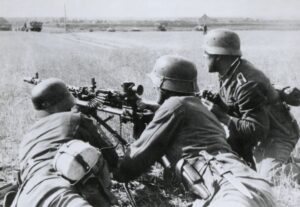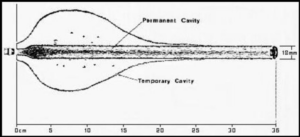I’ve Been Shot!
In movies or on TV when someone is shot they immediately fall to the ground in agony or death! But is that actually what happens to the body or is that simply drama for the benefit of our entertainment?
Of course, if a person is hit in a part of the body that is a vital necessity to assure that we can stand upright, such as a knee cap, then they will fall when shot. However, if the bullet strikes another body part such as the chest, abdomen, head, arms, etc., would the person fall down or be catapulted backwards Terminator style? Most likely they would not.
In 2005, a TV show called Myth Busters put this theory to the test. They fired a .50 caliber sniper rifle, which is a really big gun, at a dummy that was similar in size to the average adult male. When they shot the dummy, it was only knocked back 2.5 inches, not several feet.
In Mary Roach’s book, Stiff: The Curious Lives of Human Cadavers, she interviewed ballistics expert Duncan MacPherson about this phenomenon. He insisted that the effect was psychological. We see shooting victims fall down on TV and in the movies. Therefore, when someone is shot, their first response is to fall to the ground to protect themselves. However, we know from shooting animals, such as deer, that when they are shot they can travel for up to fifty yards. They only collapse after losing enough blood to be rendered unconscious.

There is further proof in war history recollections. During WWII American troops were fighting in the Philippines and China with .38 caliber rifles and handguns. The troops were shocked to find that these guns could not stop the charging enemy without having to shoot the enemy troops multiple times to bring them to the ground. Their only solution was to do more damage to the person by causing more blood loss and more tissue mutilation by using guns that fired larger bullets or firing more quickly with machine guns.
Of course, many experts are skeptical about the psychological theory of falling down when shot. They prefer to theorize that the falling is neurologically based. One neurologist theorized that the reticular activating system, which is located in the brain stem, becomes overloaded by impulses because of intense pain. Then the agony triggers the reticular activating system to send a signal to the leg which weakens the muscles and causes the person to collapse.
Of course there are several theories on this. Another theory is that when a bullet strikes a person, it creates concussive cavities in the surrounding tissue that quickly close after being opened. This type of shock could possibly send a message to the brain that something is wrong, therefore causing the brain to shut down everything and entering a safe mode. When studied in dogs and pigs, this phenomenon caused such a pressure wave to the brain that the hypothalamus and the hippocampus was damaged.
So, why does Hollywood portray gunshot wound victims being blown back when being hit by a bullet? Of course, it is for our reaction! However, Newton’s Third Law states: “any applied force is subject to an equal and opposite force.” Therefore, if this law of physics is indeed true, the person shooting the gun would also be thrown back in the opposite direction. Of course, this is never the case, so what really does happen?
When a human body is impacted by a projectile such as a bullet, the bullet enters the body, crushes and shreds tissue in its path, and creates a permanent cavity called a bullet hole. The energy of the impact of the bullet is dissipated in a shock wave that “flings” surrounding tissue away from the path of the bullet, creating a hole larger than the diameter of the bullet called a temporary stress cavity that exists for about 5-10 milliseconds with a series of gradually smaller pulsations and contractions before the formation of a permanent wound track. The extent of the final wound is determined by the kinetic energy on impact, extent of the temporary cavity and the amount of bullet fragmentation.

The amount of energy that the projectile possesses is found in the following formula: KE = W*V2/2g where W = weight of the projectile; V = velocity of the projectile; and g = gravitational acceleration.
Of course, different types of firearms and ammunition cause different types of damage with regards to the penetration, temporary cavity, and resulting injury. Handguns cause wounds with a small temporary cavity, a direct path of destruction, and minimal lateral extension. Usually, the amount of kinetic energy lost within the tissue doesn’t cause remote injury. A high-velocity rifle however, produces what is called a “tail splash” which causes the injured tissue to be propelled backwards, causes a large temporary cavity 11-12.5 times the diameter of the projectile, and the maximum cavity diameter happens at the point of maximum loss of kinetic energy. The wound track becomes permanent after the temporary cavity undulates for 5-10 milliseconds and then rests, pulling foreign material and bacteria into the wound track. Depending on what tissue is struck, a rapid cavity expansion can do severe damage at a significant distance from the wound path.
Shotguns come in different size gauges which determines the size of the ammunition. A shotgun wound presents at close range (<5 feet) as a scalloped edge wound with soot and powder seen out to 5 feet. With distance shots, the wadding abrasions/contusions may be seen as far out as 50 feet depending on the weapon and ammunition used. Exit wounds are rare.
Unfortunately, there has not been much research on this topic and the explanation remains elusive. Would you want to volunteer for such a study? I think not! Therefore, this topic may forever remain elusive.
Bibliography
Andrew, T. (2020). Wound Ballistics – Motion and Effects of Projectiles in the Human Body. Retrieved from White Mountain Forensic: https://www.whitemountainforensic.com/wound-ballistics-motion-effects-projectiles-human-body/
Pomeroy, R. (2013, July 17). Why Do People Fall Down When Shot? . Retrieved from Real Clear Science: https://www.realclearscience.com/blog/2013/07/why-do-people-fall-down-when-shot.html
Roach, M. (2021, 2003). Stiff: The Curious LIves of Human Cadavers. London : W. W. Norton & Company .
Don’t miss our newsletter! Topics covered are:
Assault / Trauma
DUI / General Medical
Child & Elder Abuse / Neglect
Mental Health / Toxicology
Sign up here.












